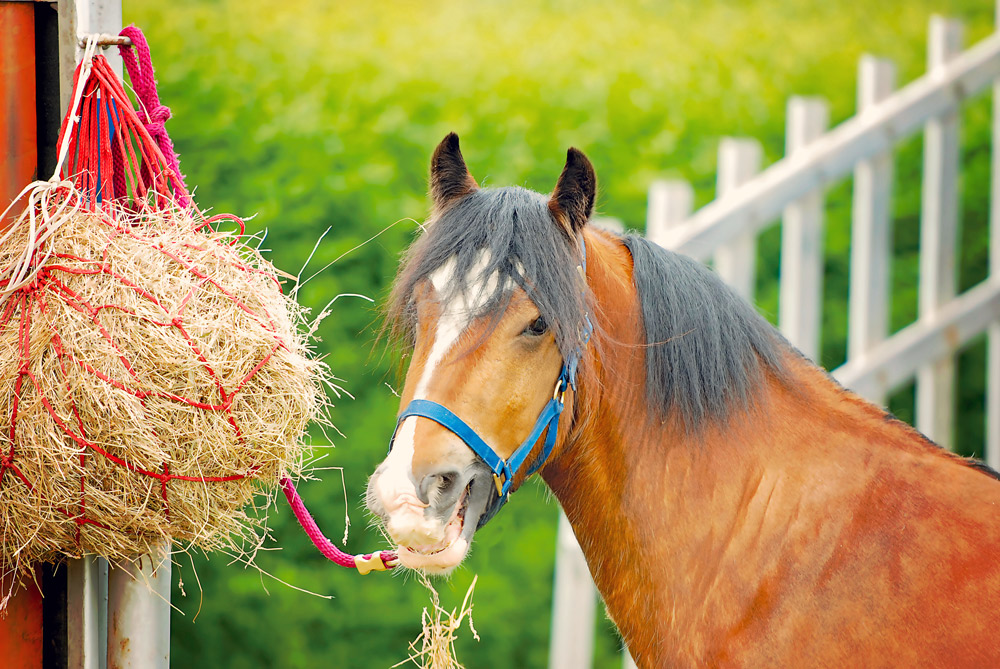Slow feeding isn’t just for easy keepers.
More and more people are looking into slow feeding as a way to offer their horses forage. But there’s a tendency to think that slow feeding is mainly for easy keepers or those with metabolic issues. This isn’t the case – any horse can benefit. Left to their own devices, horses will naturally graze 18 to 24 hours per day, but with the way many horses are kept nowadays, this natural ideal isn’t always possible. “Horses need to be slowed down because they have been deprived of forage and are mealfed for human convenience, causing emotional distress leading to boredom, stall vices and ulcers,” says Melissa Auman of Freedom Feeder hay nets.
Preventing Ulcers and Colic
Ulcers are a point of concern for many horse owners, particularly those with stall-kept and/or performance horses. “A horse’s stomach produces acid 24 hours a day in preparation for constant forage uptake, and can empty in as little as 15 to 20 minutes,” says Monique Warren of The Hay Pillow. “Saliva is alkaline, which buffers gastric acid. Under natural conditions with free choice forage, the horse will produce about five gallons of saliva every day.” This constant saliva production helps protect the sensitive stomach lining and prevent ulcers.
Slow feeding can also benefit horses that eat their hay too quickly. “Proper digestion and fermentation require time and movement,” says Monique. “A healthy hindgut is almost completely dependent on constant intake of forage. Bulky forage is needed to keep the hindgut full to prevent it from physically collapsing on itself or twisting up in a case of colic.”
Bonus benefits Regulating the easy keeper and preventing ulcers and colic are not the only advantages to this method of feeding. Here are some bonus benefits you may not have thought of: • “Hard keepers can digest and absorb more nutrients from the forage they consume,” says Melissa.
• Helps keep the beneficial gut bacteria population in healthy, consistent numbers.
• Increased chew time results in more natural tooth wear.
• Helps regulate body temperature. Microbial fermentation creates internal body heat.
• “A nervous, spooky horse will be calmed by the mastication and distraction of food,” says Monique. “If the head is down and he is chewing, there is less tension in the body and jaw.”
Getting Your Barn on Board
Whether you keep your horses at a boarding facility or at home, stalled or on pasture, you can set your feeders up in different variations for the maximum benefits of movement and consistent forage access. “It’s always a good idea to have one eating station per horse [in a pasture] so when the alpha horse comes up to the station, everyone just moves to another spot,” says Melissa. “In a boarding situation, you can put one net up front and another towards the back of the stall so the horse goes back and forth from one to the other, encouraging movement.”
Some boarded horse owners may encounter a bit of resistance when encouraging or asking their facilities to offer and maintain slow feeders.
“I understand that it’s easier to just throw the hay on the ground,” says Melissa. “However, in confining the forage to the slow feeder, horses aren’t wasting it or using it as bedding. Larger capacity nets allow for a full day’s (or even a week’s) feeding.This frees up staff time. Horses are satiated and aren’t chewing, kicking or fighting over fences.”
“In the long run, when slow feeding, you will have a healthier equine that is no longer voracious,” adds Monique. “Always consider nutrition when dealing with any health or mental issues. Feeding a balanced, low nonstructural carbohydrate diet with forage available 24/7 is healthiest for all horses.”
Monique Warren is the owner of Hay Pillow Inc. (thehaypillow.com). She has studied equine nutrition and horse’s feet for the past six years. She is in a constant research and development stage, prototyping various solutions for optimum slow feeding, and resides in Ramona, CA.
Melissa Auman is a professional barefoot trimmer, mentor and inventor of the Freedom Feeder “Pasture in a Net”tm feeding system. She has kept horses for 25+ years, is a retired trainer for Los Angeles County Mounted Assistance Units, past Vice Regional Supervisor for Camino Real region of the United States Pony Clubs, and is currently being trained in classical dressage. freedomfeeder.com.








